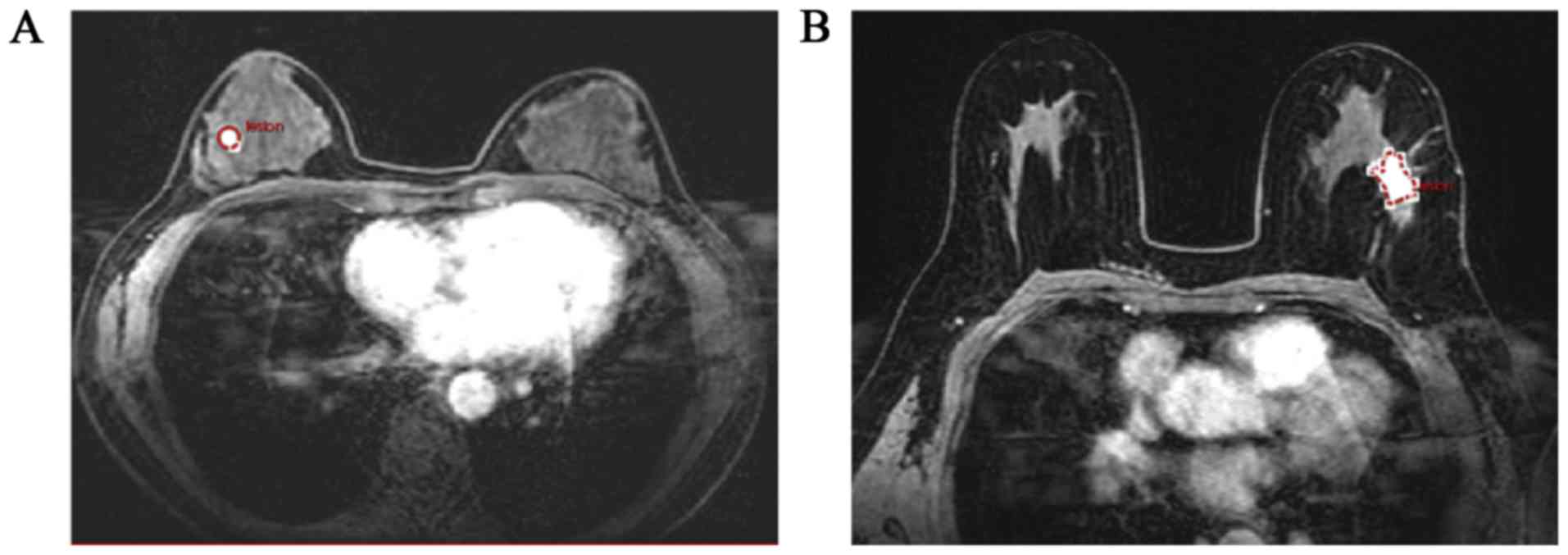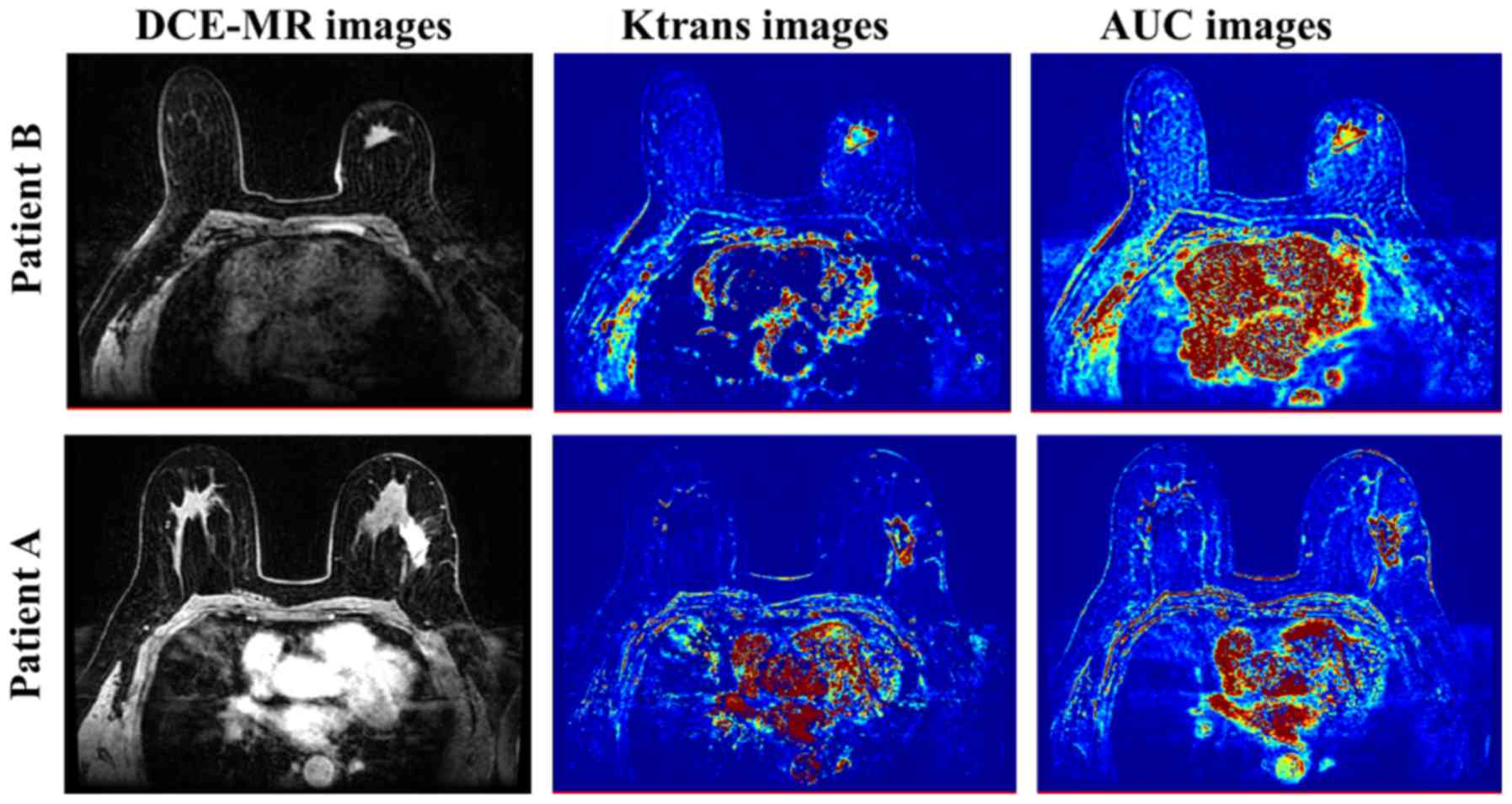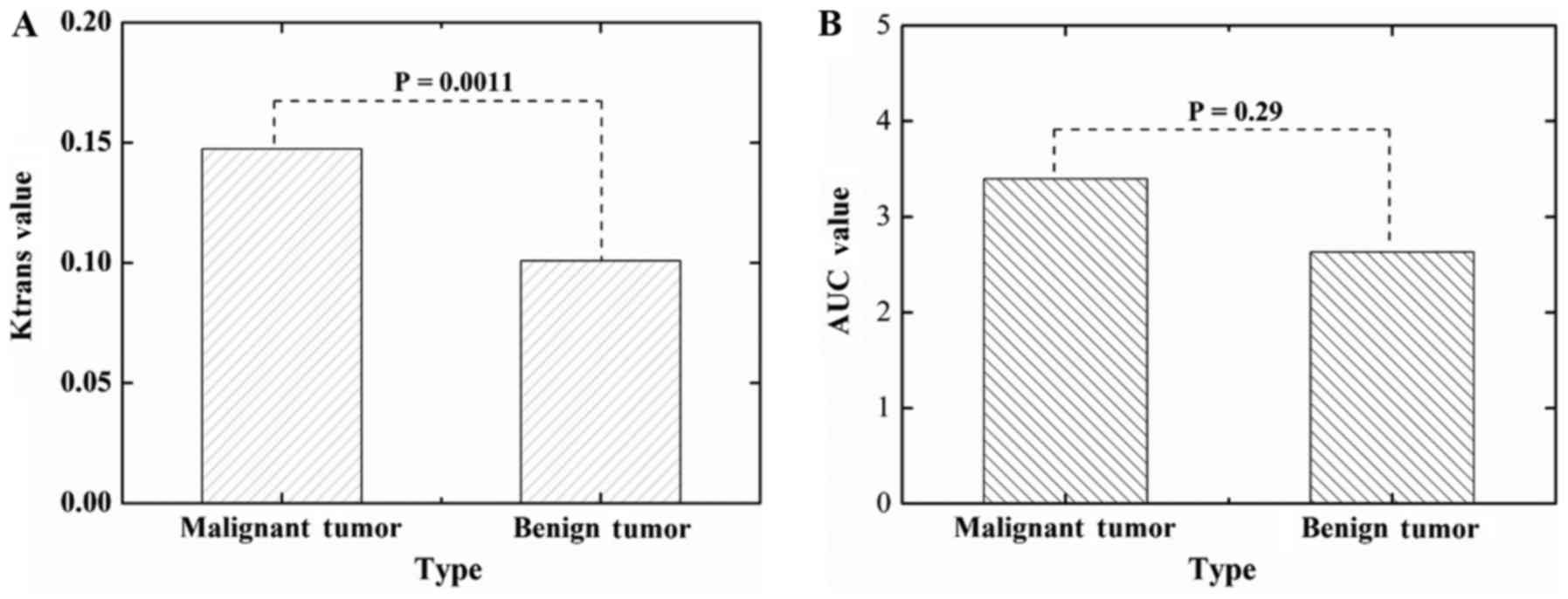|
1
|
Peters NH, Rinkes Borel IH, Zuithoff NP,
Mali WP, Moons KG and Peeters PH: Meta-analysis of MR imaging in
the diagnosis of breast lesions. Radiology. 246:116–124. 2008.
View Article : Google Scholar : PubMed/NCBI
|
|
2
|
Yankeelov TE and Gore JC: Dynamic contrast
enhanced magnetic resonance imaging in oncology: Theory, data
acquisition, analysis, and examples. Curr Med Imaging Rev.
3:91–107. 2009. View Article : Google Scholar : PubMed/NCBI
|
|
3
|
Walkersamuel S, Leach MO and Collins DJ:
Evaluation of response to treatment using DCE-MRI: The relationship
between initial area under the gadolinium curve (IAUGC) and
quantitative pharmacokinetic analysis. Phys Med Biol. 51:3593–3602.
2006. View Article : Google Scholar : PubMed/NCBI
|
|
4
|
Padhani AR, Gapinski CJ, Macvicar DA,
Parker GJ, Suckling J, Revell PB, Leach MO, Dearnaley DP and
Husband JE: Dynamic contrast enhanced MRI of prostate cancer:
Correlation with morphology and tumour stage, histological grade
and PSA. Clin Radiol. 55:99–109. 2000. View Article : Google Scholar : PubMed/NCBI
|
|
5
|
Yankeelov TE, Lepage M, Chakravarthy A,
Broome EE, Niermann KJ, Kelley MC, Meszoely I, Mayer IA, Herman CR,
McManus K, et al: Integration of quantitative DCE-MRI and ADC
mapping to monitor treatment response in human breast cancer:
Initial results. Magn Reson Imaging. 25:1–13. 2007. View Article : Google Scholar : PubMed/NCBI
|
|
6
|
Haralick RM, Shanmugam K and Dinstein I:
Textural features for image classification. Syst Man Cybern IEEE
Transact. SMC-3:610–621. 1973. View Article : Google Scholar
|
|
7
|
Holli K, Lääperi AL, Harrison L, Luukkaala
T, Toivonen T, Ryymin P, Dastidar P, Soimakallio S and Eskola H:
Characterization of breast cancer types by texture analysis of
magnetic resonance images. Acad Radiol. 17:135–141. 2010.
View Article : Google Scholar : PubMed/NCBI
|
|
8
|
Castellano G, Bonilha L, Li LM and Cendes
F: Texture analysis of medical images. Clin Radiol. 59:1061–1069.
2004. View Article : Google Scholar : PubMed/NCBI
|
|
9
|
MacKay JW, Murray PJ, Kasmai B, Johnson G,
Donell ST and Toms AP: MRI texture analysis of subchondral bone at
the tibial plateau. Eur Radiol. 26:3034–3045. 2016. View Article : Google Scholar : PubMed/NCBI
|
|
10
|
Son JY, Lee HY, Lee KS, Kim JH, Han J,
Jeong JY, Kwon OJ and Shim YM: Quantitative CT analysis of
pulmonary ground-glass opacity nodules for the distinction of
invasive adenocarcinoma from pre-invasive or minimally invasive
adenocarcinoma. PLoS One. 9:e1040662014. View Article : Google Scholar : PubMed/NCBI
|
|
11
|
Jain KK, Sahoo P, Tyagi R, Mehta A, Patir
R, Vaishya S, Prakash N, Vasudev N and Gupta RK: Prospective glioma
grading using single-dose dynamic contrast-enhanced perfusion MRI.
Clin Radiol. 70:1128–1135. 2015. View Article : Google Scholar : PubMed/NCBI
|
|
12
|
Loose J, Harz TM, Laue H, Twellmann T,
Bick U, Rominger M, Hahn HK and Peitgen HO: Assessment of texture
analysis on DCE-MRI data for the differentiation of breast tumor
lesions. Proceed SPIE-Int Soc Opt Eng. 7260:3113–3122. 2009.
|
|
13
|
Taoka T, Kawai H, Nakane T, Hori S, Ochi
T, Miyasaka T, Sakamoto M, Kichikawa K and Naganawa S: Application
of histogram analysis for the evaluation of vascular permeability
in glioma by the K2 parameter obtained with the dynamic
susceptibility contrast method: Comparisons with Ktrans obtained
with the dynamic contrast enhance method and cerebral blood volume.
Magn Reson Imaging. 34:896–901. 2016. View Article : Google Scholar : PubMed/NCBI
|
|
14
|
Chen X, Wei X, Yang R and Jiang X, Xu X
and Jiang X: Differentiation of glioblastomas and solitary
metastatic brain tumors using texture analysis of conventional MRI.
Chin Med Abs. 2016.doi:
10.3760/cma.j.issn.1005-1201.2016.03.006.
|
|
15
|
Kido S, Katamoto A, Xu R and Hirano Y:
Differential diagnosis of benign and malignant brain tumors by use
of texture analysis on FDG-PET images. Radiol Soc North Am 2013 Sci
Assem Meeting. 2013.
|
|
16
|
Tofts PS, Brix G, Buckley DL, Evelhoch JL,
Henderson E, Knopp MV, Larsson HB, Lee TY, Mayr NA, Parker GJ, et
al: Estimating kinetic parameters from dynamic contrast-enhanced
t1-weighted MRI of a diffusable tracer: Standardized
quantities and symbols. J Magn Reson Imaging. 10:223–232. 1999.
View Article : Google Scholar : PubMed/NCBI
|
|
17
|
Tofts PS: T1-weighted DCE
imaging concepts: Modelling, acquisition and analysis. Signal.
500:4002010.
|
|
18
|
Calamante F: Arterial input function in
perfusion MRI: A comprehensive review. Prog Nucl Magn Reson
Spectrosc. 74:1–32. 2013. View Article : Google Scholar : PubMed/NCBI
|
|
19
|
Bino SV, Unnikrishnan A and Balakrishnan
K: Gray level co-occurrence matrices: Generalisation and some new
features. Int J Com Sci Eng Informa. 2:151–157. 2012.
|
|
20
|
Leo HC, Evan LR and Richard DB: Fault
diagnosis in chemical processes using Fisher discriminant analysis,
discriminant partial least squares, and principal component
analysis. Chemometr Intell Lab. 50:243–252. 2000. View Article : Google Scholar
|
|
21
|
Ostrovsky E, Zelig U, Gusakova I, Ariad S,
Mordechai S, Nisky I and Kapilushnik J: Detection of cancer using
advanced computerized analysis of infrared spectra of peripheral
blood. IEEE Trans Biomed Eng. 60:343–353. 2013. View Article : Google Scholar : PubMed/NCBI
|
|
22
|
Dong L, Sun X, Chao Z, Zhang S, Zheng J,
Gurung R, Du J, Shi J, Xu Y, Zhang Y and Wu J: Evaluation of FTIR
spectroscopy as diagnostic tool for colorectal cancer using
spectral analysis. Spectrochim Acta A Mol Biomol Spectrosc.
122:288–294. 2014. View Article : Google Scholar : PubMed/NCBI
|
|
23
|
Villeda VA, Benakanakere I and Freter C:
The effect of cholesterol depletion in resistant breast cancer
cells. J Clin Oncol. 2012.
|
|
24
|
Yim H, Kang DK, Jung YS, Jeon GS and Kim
TH: Analysis of kinetic curve and model-based perfusion parameters
on dynamic contrast enhanced MRI in breast cancer patients:
Correlations with dominant stroma type. Magn Reson Imaging.
34:60–65. 2016. View Article : Google Scholar : PubMed/NCBI
|
|
25
|
Ryu JK, Sun JR, Song JY, Cho SH and Jahng
GH: Characteristics of quantitative perfusion parameters on dynamic
contrast-enhanced MRI in mammographically occult breast cancer. J
Appl Clin Med Phys. 17:377–390. 2016. View Article : Google Scholar : PubMed/NCBI
|
|
26
|
Eyal E, Badikhi D, Furman-Haran E, Kelcz
F, Kirshenbaum KJ and Degani H: Principal component analysis of
breast DCE-MRI adjusted with a model-based method. J Magn Reson
Imaging. 30:989–998. 2009. View Article : Google Scholar : PubMed/NCBI
|
|
27
|
Zheng X, Xiao L, Fan X, Huang N, Su Z and
Xu X: Free breathing DCE-MRI with motion correction and its values
for benign and malignant liver tumor differentiation. Radiol Infect
Dis. 2:65–71. 2015. View Article : Google Scholar
|
|
28
|
Yu X, Lin M, Ye F, Ouyang H, Chen Y, Zhou
C and Su Z: Comparison of contrast-enhanced isotropic 3D-GRE-T1WI
sequence versus conventional non-isotropic sequence on preoperative
staging of cervical cancer. PLoS One. 10:e01220532015. View Article : Google Scholar : PubMed/NCBI
|
|
29
|
Li X, Zhu Y, Kang H, Zhang Y, Liang H,
Wang S and Zhang W: Glioma grading by microvascular permeability
parameters derived from dynamic contrast-enhanced MRI and
intratumoral susceptibility signal on susceptibility weighted
imaging. Cancer Imaging. 15:42015. View Article : Google Scholar : PubMed/NCBI
|
|
30
|
Méndez CA, Ferrarese Pizzorni F, Summers
P, Petralia G and Menegaz G: DCE-MRI and DWI integration for breast
lesions assessment and heterogeneity quantification. Int J Biomed
Imaging. 2012:6768082012. View Article : Google Scholar : PubMed/NCBI
|
|
31
|
Coroller TP, Grossmann P, Hou Y, Velazquez
Rios E, Leijenaar RT, Hermann G, Lambin P, Haibe-Kains B, Mak RH
and Aerts HJ: CT-based radiomic signature predicts distant
metastasis in lung adenocarcinoma. Radiother Oncol. 114:345–350.
2015. View Article : Google Scholar : PubMed/NCBI
|
|
32
|
Kickingereder P, Burth S, Wick A, Götz M,
Eidel O, Schlemmer HP, Maier-Hein KH, Wick W, Bendszus M, Radbruch
A and Bonekamp D: Radiomic profiling of glioblastoma: Identifying
an imaging predictor of patient survival with improved performance
over established clinical and radiologic risk models. Radiology.
280:880–889. 2016. View Article : Google Scholar : PubMed/NCBI
|
|
33
|
Eyal E, Badikhi D, Furman-Haran E, Kelcz
F, Kirshenbaum KJ and Degani H: Principal component analysis of
breast DCE-MRI adjusted with a model-based method. J Magn Reson
Imaging. 30:989–998. 2009. View Article : Google Scholar : PubMed/NCBI
|
|
34
|
Raman SP, Schroeder JL, Huang P, Chen Y,
Coquia SF, Kawamoto S and Fishman EK: Preliminary data using
computed tomography texture analysis for the classification of
hypervascular liver lesions: Generation of a predictive model on
the basis of quantitative spatial frequency measurements-a work in
progress. J Comput Assist Tomogr. 39:383–395. 2015.PubMed/NCBI
|
|
35
|
Huang YQ, Liang CH, He L, Tian J, Liang
CS, Chen X, Ma ZL and Liu ZY: Development and validation of a
radiomics nomogram for preoperative prediction of lymph node
metastasis in colorectal cancer. J Clin Oncol. 34:2157–2164. 2016.
View Article : Google Scholar : PubMed/NCBI
|


















